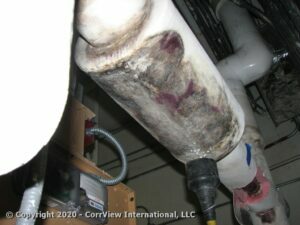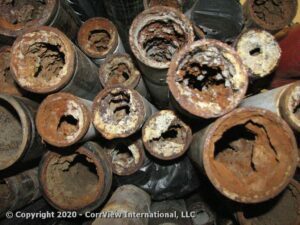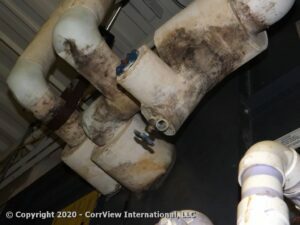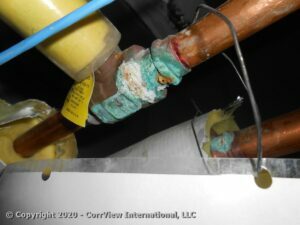Case History: CH-01
Tirelessly Following The Wrong Direction
|
Ignoring Hard Evidence Of A Massive Corrosion Problem Until Corrosion Wins Out |
-
Preface
A relatively new luxury condominium in New York City having $10+ million valued apartments has been plagued with piping failures at its package unit based condenser water piping system since opening, and has received various conflicting recommendations toward resolving its corrosion issues. They have already replaced all small threaded pipe nipples with dielectric fittings based upon a contractors suggestion that they have a system wide galvanic corrosion condition. Another consultant has installed water filtration as the solution, although backwards. Others have suggested low flow conditions as the culprit. The condo association hires CorrView International, LLC to perform an ultrasonic investigation of the condenser water piping system, and requests our recommendations to correct the problems identified.
The building has a central open condenser water system which splits into 6 sets of smaller 4 in. risers feeding individual A/C package units for the tenants. Piping ranges from 12 in. diameter near the cooling tower and pump room to 1-1/2 in. at the A/C units. All pipe is schedule 40; threaded for smaller diameters and welded otherwise.
-
Investigation
Our investigation identifies severe corrosion and pitting activity throughout the entire system. We learn from one source that no water treatment had been provided to the building for approximately its first 2 years of operation – a fact no one wants known, and asks not to be revealed. A new chemical treatment company has been retained, but after 4 months, has not yet installed their equipment nor implemented a corrosion control program. A small and undersized water filtration unit, inappropriate for the task, is installed, but it is installed backwards at a dead end section of header pipe where it provides no possible benefit.
Ultrasonic testing identifies severe pitting to near 30 MPY and documents that all pipe of below 3 in. in diameter requires replacement. Chemical cleaning, which has been planned, cannot be safely performed until this weakness of the smaller pipe is eliminated, and CorrView recommends that future failures are likely. We recommend the immediate implementation of the chemical treatment program to ensure that corrosion rates are reduced, if even possible. We also strongly recommend closing the condenser water system by the installation of a plate and frame heat exchanger and second set of pumps installed at the roof level cooling tower pump room. Water filtration needs to be relocated to be at all effective. Such steps will reduce the greater threat at an open condenser water system, allow increased chemical treatment levels, permit dual inhibitors, and allow more effective water filtration. We impress to the client that these are the only corrective measures capable of saving a significant value to the property.
 Our primary concern for the building is a high load of corrosion product which now prevents any corrosion control chemicals from reaching the underlying bare steel pipe. Barrels of removed pipe small diameter threaded sections show close to 50% constriction of their diameter due to iron oxide rust deposits. As we explain, these rust deposits represent what was their steel pipe, only now oxidized into a less dense rust product. The size or volume of such rust deposits, or “tuberculation” as it is called, is directly proportional to the volume of wall loss below, and therefore our ultrasonic investigation is also an indication to pipe constriction.
Our primary concern for the building is a high load of corrosion product which now prevents any corrosion control chemicals from reaching the underlying bare steel pipe. Barrels of removed pipe small diameter threaded sections show close to 50% constriction of their diameter due to iron oxide rust deposits. As we explain, these rust deposits represent what was their steel pipe, only now oxidized into a less dense rust product. The size or volume of such rust deposits, or “tuberculation” as it is called, is directly proportional to the volume of wall loss below, and therefore our ultrasonic investigation is also an indication to pipe constriction.
Approximately 1 year passes following submission of our first report and we are again called back to the same property. Most pipe of 3 in. and smaller has failed and has been replaced with heavy wall Type K copper tube, but new pinholes are forming at the 4 in. risers. The Chief Engineer cautiously confides that our original pipe testing report was hidden away and never make known to the condo owners, and that therefore no corrective actions were taken. Ultrasonic testing again defines very high corrosion activity near 30 MPY, and re-testing of the same areas measured earlier shows another approximately 0.035 in. loss or greater.
No benefit has been provided to the piping system by the chemical treatment provider, which now has a program in place. Doubting our results, the engineering firm overseeing the resolve of the corrosion problem purchases an ultrasonic meter and produces the same wall thickness results CorrView has reported.
Prior to submitting our second UT report, a corrosion specialist retained by the condo association contacts CorrView to demand that he receive a draft copy of our report to review and approve prior to our submission. This demand is ignored, as we do not submit draft reports for others to attempt to modify and alter toward their own interests. Furious, the corrosion consultant then advises the condo association to ignore the not yet released CorrView pipe testing report, and to continue with the cleaning and chemical treatment program they have been overseeing during the entire past year. A new corrosion coupon rack is installed by the corrosion consultant, which produces excellent results defining exceptionally low corrosion activity. Approximately 50 lbs. of a chemical cleaner is introduced into the piping system, after which total success is declared at removing all internal rust problem. Ignoring new pipe failures with rust clogged pipe removed, the condenser water system is declared to be free of all internal rust deposits.
 Another year passes and further leaks prompt a third ultrasonic investigation by CorrView International, LLC through another engineering firm. The condition of the pipe is unquestionably worse. Additional sections of larger riser pipe are replaced, and when removed and inspected, show greater than 50% constriction in their inside diameter. Shown at left, a section of 4 in. main now provides very little water flow. Ultrasonic testing identifies the deepest pitting below the largest deposits. We again find extremely high corrosion and pitting activity to near 30 MPY and now show significant weakness at the 6 in. and larger main line piping and risers.
Another year passes and further leaks prompt a third ultrasonic investigation by CorrView International, LLC through another engineering firm. The condition of the pipe is unquestionably worse. Additional sections of larger riser pipe are replaced, and when removed and inspected, show greater than 50% constriction in their inside diameter. Shown at left, a section of 4 in. main now provides very little water flow. Ultrasonic testing identifies the deepest pitting below the largest deposits. We again find extremely high corrosion and pitting activity to near 30 MPY and now show significant weakness at the 6 in. and larger main line piping and risers.
Having been advised of the low corrosion activity within the system by a review of the corrosion coupon reports over the past year, we perform ultrasonic testing at the coupon rack itself whereby we identify a very high rate of wall loss. With the 1 in. schedule 40 steel pipe from which the rack is constructed having an initial wall thickness of 0.133 in., testing measures low wall thickness values to near 0.093 in. This translates to a 0.040 in. wall loss over a one year period or exactly 40 MPY.
To confirm our ultrasonic measurements, and in an attempt to convince the condo association to the high corrosion condition present, we photograph leaks occurring at various threaded connections at the coupon rack itself. The corrosion consultant, however, maintains that their oversight of the chemical treatment program has achieved the “documented lowest measured corrosion rate in New York City of 0.4 MPY,” and advises the condo association to again ignore our third pipe testing report.
While the corrosion coupons are producing a corrosion rate estimate of near 0.4 MPY, the carbon steel coupon rack itself, within which the coupons are housed, is corroding at a rate of 40 MPY. No one, however, acknowledges this glaring contradiction. In this example, corrosion coupons are under reporting true corrosion activity by 100 times, for an error rate of 1,000 %.
The building engineer has also collected 55 gallon drums full of failed pipe which has been removed, all of which show massive internal deposits. Nevertheless, the building condo board is convinced by the corrosion specialist that the pipe is fine, corrosion activity is as low as can be reasonably achieved, and that continued dedication to the chemical cleaning and treating program will solve their problems.
-
Conclusion
Three years later we are advised that the remainder of the condenser water system has failed, and that the entire condenser water system has been replaced.
© Copyright 2023 – William P. Duncan, CorrView International, LLC






















